Alone or guided?
by Col Allison
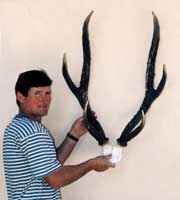 Do-it-yourself hunting is very satisfying,
but it takes time and effort. The alternative is often less costly in
the long run, as Col Allison explains.
Do-it-yourself hunting is very satisfying,
but it takes time and effort. The alternative is often less costly in
the long run, as Col Allison explains.
There really is only one way to check out new game country, chase new species and find the hot spots and the best time to hunt. And that’s to check out new game country, chase new species and find the hot spots from one end of the year to the other. Just do it.
This means extensive research, phone calls, weekends and often weeks away. It means loose ends, disappointing sojourns, wasted time and lots of money spent on tucker and fuel, not to mention wear and tear on expensive vehicles and dipping into valuable holiday or leisure time. And after all that, the success rate could be nought. I don’t know about you, but I don’t seem to have the free time I once did. What few spare hours I have are precious as a family man.
When I was young and fancy-free, I made my free time. I snatched the job or just took unpaid leave. I wasn’t on the career treadmill at first and wasn’t otherwise tied down. I did what I liked. And what I liked almost the most was to go hunting. As often as I could. So I did. Not surprisingly, perhaps, I sneered at others who paid guides to take them hunting. I took the high moral ground, a smug position made possible by daring-do, youth and no responsibilities of any consequence.
With an intolerance that, in retrospect, makes me shame-faced red today, I believed that hunters who used their cheque-book instead of Shank’s pony on their Pat Malone were somehow inferior, less worthy than those of us who did it all ourselves - from scouting the areas, finding the game, grassing it and skinning and boning it out on yer lonesome. What a smug twit I was.
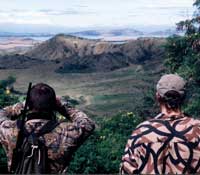 Even then, Australia and New Zealand were about the only countries where you were trusted to go hunt game on your lonesome. Just about everywhere else on earth, from Russia and Afghanistan (true) to Canada and Africa, professional guides were needed to keep the hunter honest and to keep a check on the perambulations of the great armed and unwashed - also to allow governments to monitor the health of game fields and game. Looked at another way, back then the Australian and New Zealand authorities didn’t give a damn about game management. The Kiwi government’s kill-everything approach to all antlered or horned critters could hardly be termed management. It was an extermination campaign labelled a ‘cull’. To a lesser extent it is ongoing.
Even then, Australia and New Zealand were about the only countries where you were trusted to go hunt game on your lonesome. Just about everywhere else on earth, from Russia and Afghanistan (true) to Canada and Africa, professional guides were needed to keep the hunter honest and to keep a check on the perambulations of the great armed and unwashed - also to allow governments to monitor the health of game fields and game. Looked at another way, back then the Australian and New Zealand authorities didn’t give a damn about game management. The Kiwi government’s kill-everything approach to all antlered or horned critters could hardly be termed management. It was an extermination campaign labelled a ‘cull’. To a lesser extent it is ongoing.
In the South Pacific environment of the times, the only thing holding you back from hunting then was the will to get cracking. It was an era when game quality didn’t count as much as quantity. I was the odd man out - a selective hunter in the lands of the big-tally syndrome. Why hunt for a boar with big teeth when you could clobber 300 in a week? Put ’em down first and let God sort out their teeth. That was the go then. But times have changed.
Increasingly, the ways of the world have reached Down Under. Unless you have unlimited time or are happy with common animals, hiring a guide makes a lot of sense these days. Not for every hunt, of course, but for the big ones where you may be seeking a rare trophy or an animal not easily accessible. If you want a Moluccan rusa head, for example, you have to poach it and run the risk of a hefty fine, loss of gear, loss of shooting licence or all of that - or pay to shoot on private land. There are no alternatives (which I’ll explain later in an article on this, our forgotten deer).
Anyone poaching in these times is not right in the head, though I do know hunters who absolutely refuse to pay for a guided trek - ever. Period. They are not related to Ned Kelly, at least I don’t think so, but they are thieves. Tight-fisted game thieves. So they put themselves outside the law and do nothing for the credibility of our fantastic sport.
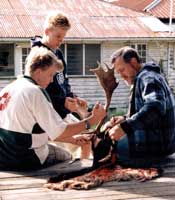 In another era, when I first started hunting, there were just two guides in Australia. They were safari guides, antipodean White Hunters operating in the Northern Territory wilderness. Their quarry was big game: crocodiles and Asiatic buffalo. Most of their clients were overseas big shots, well heeled and pampered. All these cheque-book adventurers wanted to do was fly in, shoot their animals as quickly as possible, down a few congratulatory ales and fly out again. Slam, bam, thank you man.
In another era, when I first started hunting, there were just two guides in Australia. They were safari guides, antipodean White Hunters operating in the Northern Territory wilderness. Their quarry was big game: crocodiles and Asiatic buffalo. Most of their clients were overseas big shots, well heeled and pampered. All these cheque-book adventurers wanted to do was fly in, shoot their animals as quickly as possible, down a few congratulatory ales and fly out again. Slam, bam, thank you man.
Don McGregor, a wild boy at times, and Alan Stewart, a gentleman who retired to Sydney’s west, bounced across the hoof-pitted, black-soil plains of what is now Kakadu National Park in boxy four-wheel drives. They were freewheeling entrepreneurs in khaki shorts, lords of our last great wilderness. Today there are literally scores of professional hunting guides operating on both sides of the Tasman.
Go to any SHOT Show or outdoor trades show and rest assured you’ll be overwhelmed by the guided opportunities on offer. You can chase animals that were once mythical in Australia - Chital deer, fallow, hog, red, rusa, sambar. Then there’s Blackbuck antelope, goats, pigs, buffalo, donkeys, camels, wild dogs, foxes, rabbits and hares, not to mention a raft of birds. Across the Tasman it’s the same thing, with some extra interesting species - Himalayan tahr (or thar, take your pick), chamois, whitetail and sika deer, wapiti or elk.
Some of the guides are legendary hunters, making a career doing what they love best. Some are locals who have turned their regional knowledge into a meal ticket. There are those wealthy property owners who have conned the banks into lending them plenty to set up safari parks. Other farmers are desperate to turn unprofitable range into a money-spinner. Some are just plain rogues and conmen.
Shrewdies and rustics, businessmen and bums. Some are great guides, some are awful. Some are great hosts and little else. They last years or fold faster than a well-oiled Browning over-and-under. Sometimes sorting out the hick from the slick is harder than a 50-straight clay break. But fortunately it is not as hard in Australia; word-of-mouth soon clears the air in a hobby renowned for the speed of the grapevine.
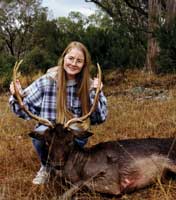 Who to trust? Don’t ask me. I don’t like making recommendations, especially with the overseas guides. Anyway, my experience with a hunting guide can be vastly different to the next bloke’s or the customer before me. The first step in getting accurate advice is to pick your expert - he’s the bod’ who’s been there, experienced the service, warts and all, and is willing to tell it like it is - recently. No good talking to the hunters who used a particular guide six years ago. Circumstances and conditions change.
Who to trust? Don’t ask me. I don’t like making recommendations, especially with the overseas guides. Anyway, my experience with a hunting guide can be vastly different to the next bloke’s or the customer before me. The first step in getting accurate advice is to pick your expert - he’s the bod’ who’s been there, experienced the service, warts and all, and is willing to tell it like it is - recently. No good talking to the hunters who used a particular guide six years ago. Circumstances and conditions change.
I can think of at least three guides who had terrific reputations for giving quality hunts at modest cost. Then they got greedy. They pushed up the number of clients they were handling. The result? More hunters, less game, smaller heads and poorer service, less customer satisfaction. Unhappy chappies and lassies who burned and churned.
The moral is obvious: check references if they’re given and wonder about it if they’re not. And only consider people with no strings attached to the hunters who have been to his block lately. But probably the main check is through the clubs. The local hunting groups meet often and know the scene well; safari clubs are for oversees jaunters.
The benefit of most clubs is that they contain very dedicated hunters, some of whom (after they get to know you) may even become friends and - dare I say it? - de facto guides to areas they know well. Many clubs have their own field properties where they might hunts pigs, goats and deer under controlled conditions. They may even own a large parcel of land.
One thing’s for sure, farmers no longer welcome you with open arms like they once did when nobody needed a guide. That was the era when few motorists locked their cars, when homes were left unbolted and murder and mayhem belonged overseas. I grew up in such simple days, when you could walk down George Street, Sydney with a rifle in a scabbard on your shoulder and no-one gave you a second glance. Gun bans weren’t even gleams in pollies’ eyes.
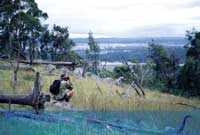 Today, the competition for hunting space is compounded by a doubling of population and suspicion from every source. Spare time is just so precious, but the good news is there’s more game about than ever before, as I’ve previously mentioned. And that can be more frustrating than encountering a record buffalo while out with a shotgun shooting ducks. The trouble is, game is invariably on someone else’s land. I was out jogging at Port Macquarie on the mid-north coast of NSW recently and bumped into a band of red deer.
Today, the competition for hunting space is compounded by a doubling of population and suspicion from every source. Spare time is just so precious, but the good news is there’s more game about than ever before, as I’ve previously mentioned. And that can be more frustrating than encountering a record buffalo while out with a shotgun shooting ducks. The trouble is, game is invariably on someone else’s land. I was out jogging at Port Macquarie on the mid-north coast of NSW recently and bumped into a band of red deer.
There are plenty of deer of at least three strains in northern NSW from releases of various kinds. But with very few exceptions they’re either on crown land or private property. Find a local who knows some owners and offer him a few bucks and the owner a trophy fee for success and you may have come across an on-the-cheap way to a thriving hunting career.
So, as the legitimate hunting areas constrict, despite the burgeoning game, more people are using guides. There are blokes I know in some clubs who only ever hunt with guides. They wouldn’t walk two kilometres into the bush without holding someone’s hand at $200 or so a day. I’m not being critical here. To each his own. Most of these coves have more spare cash than spare time. They thus have little time to do their own scouting about or they have a long wish list of desirable animals and don’t like to spend a lot of time in the boonies. Fair ’nuff.
Stiff fines, jail sentences and loss of gun licences for life will sort out the continuing poachers. Just as official culling (as is about to happen in Port Macquarie) will sort out the feral game on government-owned lands. It may well be that to hunt rare, desirable animals in future you may have to do so behind high wire, where far-sighted rural entrepreneurs have placed feral game to breed and to be hunted. Where they control who comes and goes by insisting would-be’s employ a guide they have vetted.
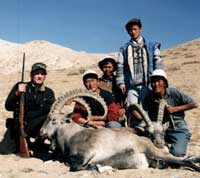 One thing about guided hunting in my experience: It usually pays dividends. You are far more likely to nail a trophy with a guide than without. Whether the guide is a card-carrying professional outfitter or just a bloke you know who does a lot of hunting in an area unfamiliar to you. They know the range; they know the animals’ habits. But don’t aim too high just because a second pair of eyes is working for you.
One thing about guided hunting in my experience: It usually pays dividends. You are far more likely to nail a trophy with a guide than without. Whether the guide is a card-carrying professional outfitter or just a bloke you know who does a lot of hunting in an area unfamiliar to you. They know the range; they know the animals’ habits. But don’t aim too high just because a second pair of eyes is working for you.
The biggest mistake most hunters make is having unrealistic goals. Don’t insist on grassing a goat with 40-inch horns when the best head ever shot in the district is barely 37 inches long. Take the guide’s advice. If he says, “You should take this one,” give it a lot of thought before saying no to a 36-incher if you haven’t previously shot one that big. Providing it is not a lazy guide, consider hard.
Too many people who hold out for Old Moss Horns end up disappointed. I know this from personal experience. The guide will do his very best in most cases. But the impossible may take a little longer than you have or can afford. My view is you should always take a representative head or better on your first trip, aiming to do far better the next time around. But if you do crack the jackpot and nail Old Moss Horns’ hide to a tree, you’ve got yourself a guide to cherish. A tip is in order here.
Incidentally, I’m off to South Australia in two weeks, hunting big fallow bucks. I don’t know the area at all, so guess what? I’ve hired a guide. Let you know how it goes.
